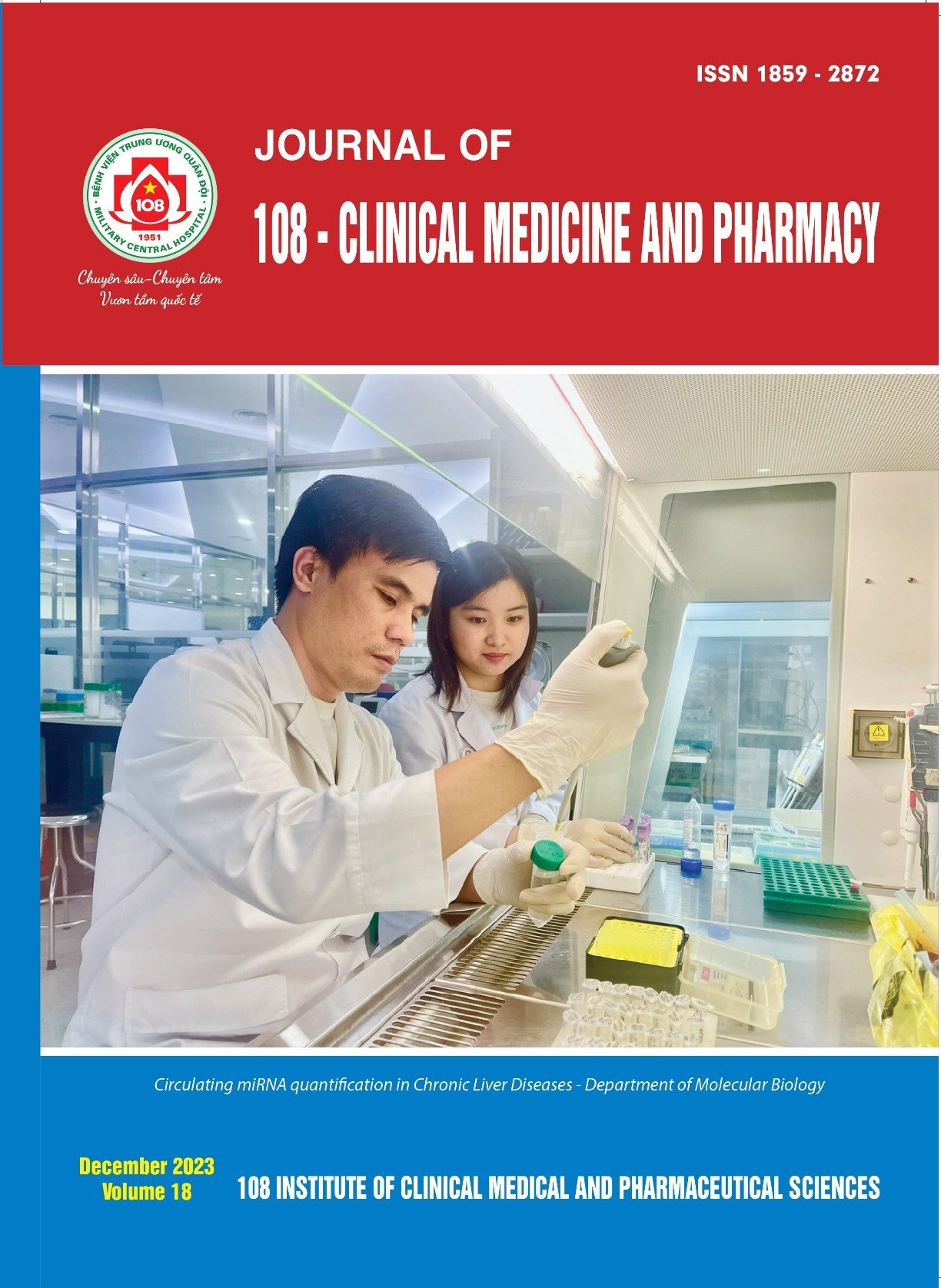Intracerebral hemorrhage in young adults: Analysis of etiology, clinical characteristics and discharge outcome
Main Article Content
Keywords
Tóm tắt
Objective: This study evaluated the etiology, clinical characteristics and discharge outcomes of intracerebral hemorrhage (ICH) without trauma in young adults admitted to a comprehensive stroke center. Subject and method: This was a retrospective study of patients aged under 46 years with nontraumatic ICH admitted from October 2022 to April 2023. Data was collected on demographics, clinical history, hemorrhage location, possible etiology, and discharge outcome. Categorical data was reported as percentage. Chi-squared test was performed to evaluate association of location of ICH, etiology of ICH with the discharge outcome. Result: Forty-five patients met the study criteria, with mean age 35.6 ± 8.1 years including 16 (35.6%) female, 29 (64.4%) male. Headache (86.7%) and hemiparalysis (77.8%) were the most common symptoms. Hematoma was most commonly seen in the deep structures in 21 (46.6%) patients followed by lobar ICH in 17 (37.8%) patients. The most common etiology of ICH was hypertension, which seen in 23 (51.1%) patients, followed by vascular abnormalities in 13 (28.8%) patients. Twenty-two patients (48.9%) had good outcome defined as mRS 0-2. Twenty-three patients (51.1%) had poor outcome with mRS 3-6 at discharge. Location and etiology of hemorrhage were not associated with discharge outcome. Conclusion: Hypertension, a modifiable risk factor, is a major cause of nontraumatic ICH in young adults. In primary care settings, hypertension and life styles were important modifiable risk factors for all subtypes of strokes. Considering that hypertension is an independent risk factor for morbidity and mortality in patients with ICH, this comorbidity should be managed aggressively in young patients as part of a primary prevention strategy related to ICH.
Article Details
Các tài liệu tham khảo
2. Ruiz-Sandoval JL, Romero-Vargas S, Chiquete E et al (2006) Hypertensive intracerebral hemorrhage in young people: Previously unnoticed age-related clinical differences. Stroke 37(12): 2946-2950.
3. Tatlisumak T, Cucchiara B, Kuroda S et al (2018) Nontraumatic intracerebral haemorrhage in young adults. Nat Rev Neurol 14(4): 237-250.
4. Meretoja A, Strbian D, Putaala J et al (2012) SMASH-U. Stroke 43(10): 2592-2597.
5. Van Asch CJ, Luitse MJ, Rinkel GJ et al (2010) Incidence, case fatality, and functional outcome of intracerebral haemorrhage over time, according to age, sex, and ethnic origin: A systematic review and meta-analysis. Lancet Neurol 9(2): 167-176.
6. Ruíz-Sandoval JL, Cantú C and Barinagarrementeria F (1999) Intracerebral hemorrhage in young people: Analysis of risk factors, location, causes, and prognosis. Stroke 30(3): 537-541.
7. Rutten-Jacobs LCA, Maaijwee NAM, Arntz RM et al (2014) Clinical characteristics and outcome of intracerebral hemorrhage in young adults. J Neurol 261(11): 2143-2149.
8. Lai SL, Chen ST, Lee TH et al (2005) Spontaneous intracerebral hemorrhage in young adults. Eur J Neurol 12(4): 310-316.
9. Kalita J, Goyal G, Kumar P et al (2014) Intracerebral hemorrhage in young patients from a tertiary neurology center in North India. J Neurol Sci 336(1-2): 42-47.
10. Koivunen RJ, Satopää J, Meretoja A et al (2015) Incidence, risk factors, etiology, severity and short-term outcome of non-traumatic intracerebral hemorrhage in young adults. Eur J Neurol 22(1): 123-132.
11. Zahuranec DB, Lisabeth LD, Sánchez BN et al (2014) Intracerebral hemorrhage mortality is not changing despite declining incidence. Neurology 82(24): 2180-2186.
12. Toffol GJ, Biller J and Adams HP (1987) Nontraumatic intracerebral hemorrhage in young adults. Arch Neurol 44(5): 483-485.
13. Olavarría VV, Bustamante G, López MJ et al (2014) Diagnostic accuracy of a simple clinical score to screen for vascular abnormalities in patients with intracerebral hemorrhage. J Stroke Cerebrovasc Dis 23(8): 2069-2074.
14. Delgado Almandoz JE, Schaefer P W, Goldstein JN et al (2010) Practical scoring system for the identification of patients with intracerebral hemorrhage at highest risk of harboring an underlying vascular etiology: the Secondary Intracerebral Hemorrhage Score. AJNR Am J Neuroradiol 31(9): 1653-1660.
 ISSN: 1859 - 2872
ISSN: 1859 - 2872
